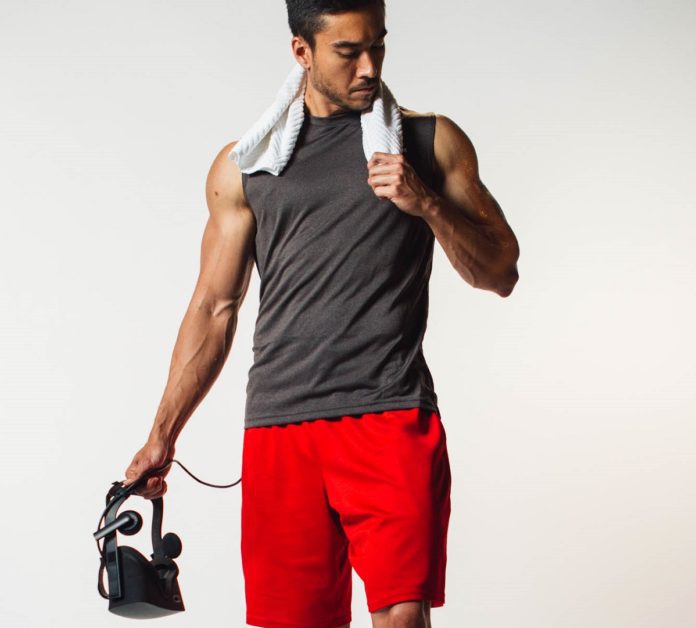Every time somebody online mentions that they used their HTC Vive for working out, I know exactly what at least half of the comments will be:
“Sweating in your headset? No thanks.”
“Your HMD will fog up and eventually break. Don’t do it, bro.”
“Oh nasty. I’d hate to be the one to use the Vive after you.”
It’s a concern that some people bring up as a reason that working out in VR will never catch on. They can’t imagine that anybody would want to be active in virtual reality and purposely use it to get in shape. Worse, they assume that if you do it, your precious Vive or Rift will be immediately and irreversibly destroyed, ending your Tilt Brush artist career aspirations forever.

And guess what? They are dead wrong.
90% of the time the person making this complaint has never actually tried it. They also haven’t spent any time learning how to mitigate sweat and fog and making it a completely hygienic experience.
I’ve personally worked out very hard in virtual reality over a hundred times, usually for 30 minutes or more at a time. After making some slight modifications to the headset and to my routine, I don’t even notice sweat at all.
Many sports require the athletes to wear helmets or goggles for activities that are much more rigorous than any virtual reality workout. For example:
Here’s what to do.
Here’s what to do now and what we can look forward to in the future as VR Fitness and all of the amazing capabilities it brings moves into the mainstream.
Use a headset cover.
Did you know that the HTC Vive foam face pad is easily removable? You can change the pad or put a cover on it in only a few seconds. The default foam pad is definitely not optimal for sweating as it absorbs liquid very easily.
There are a large number of covers or face pad replacements available online. A few options are:


Our favorite is the PU Leather option from VRCover.com. Look how easy it is to put it on:
They are also very easy to take off at the end of your session:
If you share your Vive or Rift with others, you can each have your own cover or use disposable covers and never have to worry again.
Wear a sweatband or full head cover.
When I first started working out in VR, I would have to remove the headset a few times during the more intense parts of the experience to wipe sweat from my forehead so it wouldn’t get into my eyes. This is typical of any type of workout experience and is easily avoided by wearing a headband of some sort.
Wearing a full head cover (like they do in many sports with helmets) will also prevent sweat from getting onto the head strap on the back of your head.
Wipe down between uses.
As with any type of equipment that you put on your body, it’s smart to clean it from time to time. VR devices are simple to wipe down, preferably with just a soft cloth and water. Using harsh chemicals could cause the materials to break down sooner.
Point a fan at your play space.
Your body sweats to cool down. Using a fan and keeping the room cool will help to lessen the amount of sweat your body produces in the first place. For some light workout experiences, you may not even sweat at all.
“But won’t a little sweat ruin my headset? An anonymous guy online said so.”
Obviously dunking most electronic devices under water will destroy them, but VR headsets are made to be worn on the face for experiences where you are moving around in a room-scale environment. This means moving quickly, shooting virtual bows, dodging bullets, and much more. Many people sweat profusely even with light activity. Headsets are made to be worn on the faces of any human, not just the ones that are blessed with natural antiperspirant.
At Black Box VR, our team has collectively worked out in a single HTC Vive headset hundreds and hundreds of times and we haven’t had a single issue. I’m talking about resistance training and hardcore Tabata-style squat jumps where we get our heart rates up to 80 – 90% of our max for extended periods of time.
Using sweatbands and face covers further reduces the chance of having a problem. Don’t worry about it. Your headset can take it. Seriously.
Try it
Next time you hear some random person on the Internet saying that sweating in a headset is not comfortable or not a good idea, just ask them one question: “Have you tried it?” Almost every time you will get a no.
The fitness industry’s dirty secret is that most people that start a fitness program or join a gym do not get the results that they desire. Why? They don’t stick with the program. Working out is hard, boring, and time-consuming. VR brings amazing new capabilities that can completely revolutionize the fitness industry in all of the right ways.

Myths around sweat and hygiene scare potential users away unnecessarily, keeping them from improving their health and fitness. Let’s all work together to get the truth out there! The world needs VR fitness.


















